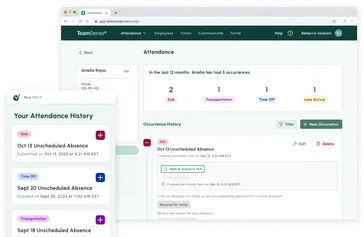Fix the root cause of No-Call No-Show with help from TeamSense
Table of Contents
In November of last year, I joined our CMO Justin Sears for a webinar discussion on how fast and easy it is to integrate our TeamSense attendance management and employee communication solution with an existing human resources information system (HRIS). You can watch the entire replay here.
This recap post is for people who missed the original webinar. I’ll cover the key points and share the relevant video clips here, to help you digest the webinar in bite-sized chunks. Justin and I were joined by our colleague Shannon Lambert, who asked us questions from the audience, and I’ve included that Q&A at the end.
Justin and I covered a lot of ground about integrating TeamSense with an existing HRIS or other HR platforms, but I’d say that the five main topics were:
The typical time and effort needed for a TeamSense integration
How TeamSense and an HRIS make each other better
What customers tell us after they’ve gotten integration running
The two basic types of data integrations we do for our customers
How TeamSense users benefit from seamless integration
Typical Time and Effort Needed for a TeamSense Integration
Of course our goal is to make integrations fast and simple. The time it takes to integrate largely depends on factors that our clients control, such as giving us system access and mapping their data accurately. Most of the effort is also with our customers. TeamSense has a modern cloud architecture, so our system needs to know which endpoints to connect to and what data format to expect. Our Customer Success team and I work together with our new customers to recognize repeatable patterns in those areas and also to identify unique differences that we need to accommodate. Then the process usually goes smoothly and quickly.
How TeamSense and an HRIS Make Each Other Better
One common misconception that Justin asked me about is whether TeamSense replaces an HRIS. All the opposite! TeamSense works hand-in-hand with an HRIS, enhancing it by providing additional information to employees, supervisors, GMs and HR teams. For example, real-time notifications to managers make information that will eventually be available for reporting in the HRIS immediately available in TeamSense for decisions on the floor. Also, TeamSense’s ability to expose crucial attendance information, such as time-off requests and attendance points availability, proves invaluable for employees and supervisors alike.
What Customers Tell Us After They’ve Gotten Integration Running
With each integration, we explain the general benefits of integrating TeamSence into the customer’s HR ecosystem. One of the best parts of my job is to hear all of the stories of the specific things that our customers see more clearly once they have real-time access to the data in TeamSense. For example, visibility into a specific absence or an employee’s history of absences helps resolve disputes between employees and management–because they both have confidence in the same data. After all, it was usually entered by the employees themselves, and then captured automatically. Absences jotted down on a sticky note by a manager or HR don’t always make it into the employee’s attendance record by the end of the day.

In fact, this transparency and accountability has recently become valuable for one of our customers during negotiations between management and union workers. They found that this functionality–employees having the easy ability to see the attendance points that they have at any point in time–has been a big benefit to those union workers and that transparency builds trust during negotiations.
The Basic Two Types of Data Integrations We Do for Our Customers
I told Justin about two major types of integrations that TeamSense offers for our manufacturing and logistics customers. (We do have other sorts of customers, but the huge majority are in those two industries.)
The first type of integration involves “data in” – syncing employee data from an HRIS into TeamSense. The second type revolves around “data out” – sending employee absence data from TeamSense back into an HRIS. These seamless inbound and outbound synchronizations ensure that critical information flows effortlessly between systems, enhancing system efficiency and data accuracy.
Our goal is to make TeamSense integrations as easy as possible for our customers. We have pre-built integrations with Workday and Ceridian Dayforce, and other major HRIS, with many examples of them working and in action. When we're able to set those up, it's usually just a matter of making sure that we have system access and then doing some testing to make sure everything’s connecting correctly.
For some customers that can mean an API integration to their HRIS. For others, it's something like a SFTP or reporting-as-a-service (RAAS) update. But either way, we find some way to work with the customer’s system and get them that data.
How TeamSense Users Benefit from Seamless Integration
Three different groups of TeamSense users benefit from integrating TeamSense with HRIS.
First, hourly employees love TeamSense because we make the call-off process so much easier. They haven't had to do anything necessarily to use TeamSense because their employee profile was already been uploaded through their HRIS–automatically in that integration. When they call in (better put, when they “text in”, because 95% percent of our users prefer to use text than voice or email) they don't have to worry about whether or not they're going to reach their manager.
Secondly, supervisors benefit because they get that notification automatically. They don't have to go check their HRIS manually or wait on a phone call or get hearsay from an HR business partner. They get a text message to their phone and they're able to see that that employee is off. With one more click, they're able to see at a glance everyone on their entire team that is off for the day. That awareness saves them time and money and allows them to get their line running faster.
And finally, we hear that most HR teams at factories and distribution hubs spend 5-10 team hours per week manually wrangling absence data. They listed to call-off voicemails or read emails in the morning, to learn who’s off for the shift. They move absence data from one system into another system. A well-integrated instance of TeamSense eliminates all those manual data entry tasks for supervisors and HR professionals, saving considerable time and streamlining their daily work, so they can focus on improving productivity and employee engagement.
Questions and Answers from the Q&A Portion of the Webinar
-
The turnkey integrations are integrations that we've already confirmed are working and set up. So these are things that we've already done all of the difficult work of making sure that we're able to access and send the data at all. And at that point, really, the only thing we need to do is work to make sure that we have the appropriate access that we need. Once we've done that we at TeamSense finish those connections and set everything up and make sure it looks properly.
For those non-turnkey integrations, those are the ones that require more discovery work where we have to find out what's available at the HRIS. Maybe we build out the connectors to it manually or maybe build out a report through the RAAS (reporting-as-a-service). Those require a little bit more effort and may take a little bit more to get them up and running.
-
The most recent integration that I've been working on actually is to get points out of Ceridian Dayforce. We have a company that has said that this has been a big benefit to their union workers because we've been able to expose otherwise really hard-to-find information to those workers. I don't know the details of their negotiations, but I've heard that it's been a big benefit to the company.
This also helps to remove human error, with the potential of accidental misreporting or even–we'd hate to think of it–intentional misreporting, so it makes sure that everybody has 100 percent transparency.
-
So far, we've pretty much run the gamut of HRIS connections. I think that the most common one so far has probably been Ceridian Dayforce. I've got two of those that I'm running right now. Maybe followed up closely by ADP, as we have a couple of those. Either done or in the pipeline as well. I think my wife's company even uses ADP. So I think Ceridian and ADP are the two biggest that I've seen.
-
We offer automatic exports of the basic attendance summary that an admin can see when they log into TeamSense. We also offer an automatic export of the forms responses–the line-by-line response that anybody has given to an absence form.
We can deliver those automatically, and then how you handle that data afterwards is up to you. In terms of exporting the analytics data, currently I don't think we have a way to export that, but I know that's something that we've heard requests of before, and it's something that we have looked into.
-
I think it really depends on a couple of things. One would be how big your company is and how many people you're looking to start TeamSense with. The other thing is how or what your timeline looks like. The quicker you're looking to roll out, it may be a little difficult to also get the integration up and running within that time frame. We have to be realistic about those goals. If you have a lot of employees that you're onboarding, it might be a lot easier to just wait until that integration is confirmed and working so that you can get all of them imported at the same time, rather than having to work through that data on your own and have us import it.
For example, we just onboarded a new company. And instead of having HR individuals from four different locations get 3,000 employees’ data collected for me, we were able to just turn on the integration and get all of that imported automatically.
-
We handle language preferences in TeamSense. We support 20-something different languages. Depending on what your company supports, at TeamSense we can, in the integration, import any language preferences that are stored in your HRIS. We store that preference with that employee, and then whenever we deliver them any sort of form, that form will be translated into the language that they prefer.
Communications won't be sent automatically translated because those are things that the HR person has usually written out, but we will translate anything that we can to their preferred language.
-
A lot of our integrations are set-it-and-forget-it, but we also are very flexible to work with the companies to make sure that everything stays working correctly. Sometimes what this can look like is maybe a change in reporting structure where we need to change how notifications or supervisors are set up. Other times this could maybe be a new division and we're adding a new site, so we have to change some parameters for the integration to configure that.
I think the only other thing that we usually see changed after an integration is set up, is when a different time and attendance event is being sent into their HRIS. Maybe we're updating available options for their employees, but those are usually the only upkeep that we see.
Schedule a Demo to See TeamSense. Then We Can Talk Integration.
If you're intrigued by the potential of integrating TeamSense with your HRIS, schedule a demo so we can learn about your specific goals and show you how the product works.
We’d love to show you and your team how easy it can be to get TeamSense up and running. The user experience is intuitive and requires very little training. If you have your data ready, we can go live as quickly as you can give us access to your HRIS or other platforms involved in integration.
About the Author



